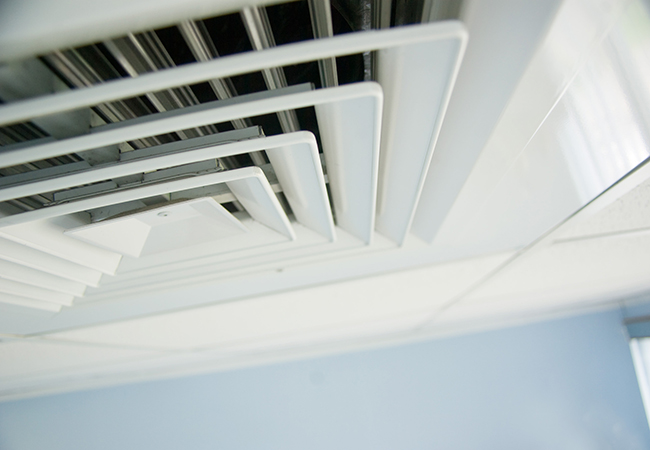
Poor fan coil (terminal) unit design is an oft-neglected topic that can have a major impact on occupant comfort and health. The subject was tackled at the CIBSE UAE Healthy Buildings Conference, however, by Imran Shaikh, CIBSE UAE vice-chair and senior lead mechanical engineer at SSH.
He emphasised the importance of understanding the difference between correctly sized and oversized – or poorly sized – units. His presentation focused on residential and hotel guest-room applications, where the sensible load is dominant, and clearly differentiated this from other applications, where latent load may be more significant.
Shaikh highlighted the need to select equipment to meet the calculated sensible cooling load at appropriate design conditions. Selecting equipment based on the calculated total cooling load (that is, sensible plus latent loads) can, in some instances, result in higher-than-desired sensible cooling capacities and higher flowrates. In such instances, the off-coil temperature becomes higher, so preventing the unit from providing sufficient dehumidification.
Referring to a number of common myths, Shaikh first rejected that more cooling capacity means better thermal comfort, as it can actually lead to the supply of excess air, resulting in poor air distribution, draughts and occupant discomfort. The setpoint temperature is also likely to be achieved swiftly, so – as the off-coil temperature increases – dehumidification reduces and the room humidity increases, adversely impacting occupant comfort and, potentially, health.
Selecting equipment based on total cooling load can result in higher than desired sensible cooling capacities and higher flowrates
Another myth is that large load ‘safety’ factors will lead to a robust design. The risk is that the summation of all the excessive load ‘safety factors’ in the lighting, equipment, infiltration, occupant density and activity increases the installed sensible cooling capacity significantly (together with a smaller impact of the calculated latent load). This will lead to oversizing, with the inherent problems previously discussed.
The final myth that Shaikh destroyed was that a higher installed capacity results in lower humidity – as discussed above, this is not likely to be the case. It could actually result in surface condensation as the room humidity rises and, potentially, mould, which will impact human comfort and health. He reiterated the importance of assessing all loads properly, including fabric, lighting, equipment, infiltration, occupant density and activity schedule; this will inform a correctly selected unit.
Considering a typical air conditioning layout for a hotel guest room in the Middle East region, Shaikh said that, when selecting units, he generally considers the performance of the terminal units at medium and high speed. He then identifies five or six suitable models from two manufacturers that meet cooling performance as well as other criteria, including noise performance and physical dimensions. This will allow the unit to operate at medium speed for all but extreme load conditions, when it can be operated at high speed for a short period of time.
There is little point sizing units correctly for the system specification if the material approval process is not also done with care
Shaikh would normally size the final duct with a low velocity of around 2m.s-1 and the entry to grille at 1.5m.s-1, with the (vertical) supply grille single-direction blades facing upwards at 50 degrees to the horizontal, to help prevent ‘dumping’. The lower velocity helps to limit the pressure drop to 20Pa to 30Pa (compared with a more normal 50Pa) so allowing, in most cases, a smaller FCU.
This will not only provide better thermal comfort, but also reduce noise. Other benefits of using lower-velocity systems include reducing the possibility of particulate matter getting carried through the system into the space, and a reduced opportunity for draughts, as well as lower turbulence.
Shaikh was clear that there is little point in taking care to size terminal units correctly for the system specification if the material approval process is not also undertaken with care. At this stage, he undertakes a psychrometric analysis to ensure there are no fundamental issues with the selections received from the manufacturers or the contractors.
He then does a capacity comparison with the specified units by employing the psychrometric plots to verify that the total and sensible loads can be met with the offered units. If they cannot, that raises questions and these concerns need to be taken to the manufacturer in terms of the offered equipment and the suitability for the application.
In his full presentation (which can be viewed here), Shaikh provides examples from real-world case studies and concludes with some ‘do’s and don’ts’ for proper terminal sizing:
- Always employ calculated values in the equipment schedule
- Do not apply the worst-case orientation heat load for similar, but different aspect, spaces in a development
- Closely size units based on accurate design conditions and don’t ‘over specify’ the FCUs
- When employing multiple FCUs as a group, psychrometrically assess the on-coil and off-coil conditions and the sensible and total capacities for each FCU
- Although debatable, he suggested not to control on a return sensor for guest rooms – his preference is to control based on the room-temperature sensor in the space.
- Tim Dwyer is technical editor at CIBSE Journal
